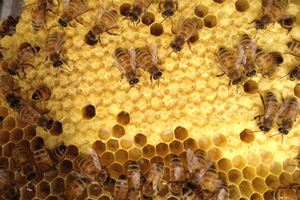- All-In-One Beekeeping for the Bees
- +1-608-728-8233
- info@beepods.com
Fall Hive Inspection Tips to Help Your Bees Store Enough Honey for Winter


While warm and balmy August still lingers, crisp fall days will be here before we know it. Just like you might start loading up on your favorite fall spices and baking essentials, bees are hard at work assembling their food stores and getting the hive ready for the colder months ahead.
It’s a beekeeper’s job to make sure your bees are using fall months to prepare honey for winter. In this post, we’ll cover our top tips for ensuring your bees are on their way to a honey-ful winter during fall inspections.
How Much Honey Bees Need for Winter

Preparing for winter: this comb is full of capped and uncapped honey.
Going into your fall inspections, you should have a good idea of whether honey production has been great or not-so-great in the spring and summer. Hopefully, you’ve been keeping track of your ladies’ hard work with regular inspections and staying on top of how they’re doing.
The average beehive needs about 40 lbs of honey going into winter, with moderate climates requiring 60 lbs, and extreme winter zones calling for 90 lbs. That’s a lot of honey! If you’re finding during inspections that your bees haven’t had too much success with honey this year, you might consider these steps to help them get ready for winter.
Rob the Hive – But for Good Reason!

The Beepods Harvest Box is perfect for storing some of the bees’ honey to give back to them going into the winter.
One way to give your bees a honey-making boost is to take their honey from them – that’s right, rob the hive. We promise it’s okay, though. Removing honey from the hive during productive warmer months will not only motivate your bees to get to work and make more honey, but it will also help prepare them for a cold, forage-less season.
The honey you take and store for the bees will be a welcomed feast when you serve it back to them to enjoy during the winter. Use a Beepods Harvest Box to safely store that well-deserved honeycomb for your ladies. Just don’t take honey later in the fall – they need it!
Give Them a Boost
Are your inspections showing that your bees just aren’t producing enough honey? As spring and summer blossoms start to dwindle, but there still is a fair amount of sunlight and heat, bees don’t enjoy as much success when they’re out foraging. If your bees need additional nutrition sources as winter approaches, you can help ensure they fill their tiny bellies and their hive.

Some of our ladies slurp up some delicious sugar water, a helpful supplemental nutrition source to aid their honey making!
A delicious 2:1 mixture of sugar and water (two parts sugar to one part water) gives bees a thick syrup, similar to honey, that provides additional nutrition. You’ll want to avoid anything but regular sugar, since other sweeteners can make bees sick or cause them harm. This yummy substance will also entice other creatures and critters looking for food, so take precautions when you’re feeding it to your bees. Caitlin wrote a great blog full of tips and best practices for supplemental feeding that you can find here.
Keep The Bees Cozy
As you inspect hive bars and assess comb production, you can arrange the bars to build layers of heat retention for the bees to enjoy as temperatures drop. Bees don’t just chow down on honey – it also serves as a heating tool in the hive. Bees generate friction that heats the honey, and the honey does a pretty good job of maintaining that heat.
Help your bees make their hive-warming efforts the most efficient by positioning the bars to insulate the hive (and feed them, of course). Move bars with a comb full of honey and nectar toward one end of the hive, and place bars with partially-developed or empty comb at the other end. This will give the bees plenty of honey to eat and heat with as the winter approaches.
Conclusion
Whether your bees are approaching winter ready-to-go or need some support, fall inspections are a great chance to see where they’re struggling and how you can help. Your actions now can be the difference between well-fed bees in the winter, or a colony that scrapes by to make it to spring. So grab your sweater and head out to see how you can help your ladies prepare for the cold!
Want more inspection tips?
Check out Beepods Lab for informative step-by-step videos on how to carry out hive inspections.
Kanoe Riedel
Latest posts by Kanoe Riedel (see all)
- This Spring, Don’t Forget Why Bees Are So Important to Our Environment - March 26, 2021
- 11 Awesome Uses for Your Stored Honeycomb - March 2, 2021
- How the Right Beekeeping Equipment Makes Inspections Better for Beekeepers and Bees - February 12, 2021



